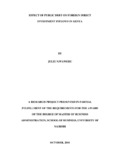| dc.description.abstract | The biggest challenge facing LDCs to attain sustained and equitable economic growth and development is inadequate domestic financial resources. This has led to heavy reliance by most LDCs on external capitals such as foreign direct investment, concessional lending and remittances and foreign aid. Huge dependence on foreign capital has however exposed the country to high levels of external debt. Despite the fact that 60% of the LDCs have either benefited or are working towards benefiting from the debt relief under the Heavily Indebted Poor Countries (HIPCs) initiative and Multilateral Debt Relief Initiative (MDRI) and other bilateral donors, they are still struggling with high debt burdens. Kenya is facing the same predicament with accumulation of public debt and shrinking foreign aid especially from the 90s after the freezing of donor aid. This study sought to determine the effect of public debt on foreign direct investments inflows in Kenya. The independent variable was public debt as measured by quarterly public debt in natural logarithm form. The control variables were interest rates as measured by central bank lending rate on a quarterly basis, economic growth as measured by quarterly GDP, exchange rates as measured by quarterly exchange rate between ksh and usd and inflation rates as measured by quarterly CPI. FDI inflows in Kenya were the dependent variable which the study sought to explain and it was measured by FDI inflows in the country on a quarterly basis. Secondary data was collected for a period of 10 years (January 2008 to December 2017) on a quarterly basis. The study employed a descriptive research design and a multiple linear regression model was used to analyze the relationship between the variables. Statistical package for social sciences version 21 was used for data analysis purposes. The results of the study produced R-square value of 0.673 which means that about 67.3 percent of the variation in FDI inflows in Kenya can be explained by the four selected independent variables while 32.7 percent in the variation was associated with other factors not covered in this research. The study also found that the independent variables had a strong correlation with FDI inflows (R=0.820). ANOVA results show that the F statistic was significant at 5% level with an F statistic of 13.976. Therefore the model was fit to explain FDI inflows in Kenya. The results further revealed that individually, public debt, interest rates, economic growth, exchange rates and inflation rates are not significant determiners of FDI inflows in Kenya. This study recommends that there is need for policy makers to regulate public debt levels prevailing in the country bearing in mind that they can influence FDI inflows in the country. | en_US |



